
Organic Chemistry
An Acid-Base Approach
Michael B. Smith
- 686 pages
- English
- ePUB (mobile friendly)
- Available on iOS & Android
Organic Chemistry
An Acid-Base Approach
Michael B. Smith
About This Book
Based on the premise that many, if not most, reactions in organic chemistry can be explained by variations of fundamental acid–base concepts, Organic Chemistry: An Acid–Base Approach provides a framework for understanding the subject that goes beyond mere memorization. Using several techniques to develop a relational understanding, it helps students fully grasp the essential concepts at the root of organic chemistry.
This new edition was rewritten largely with the feedback of students in mind and is also based on the author's classroom experiences using the previous editions.
Highlights of the Third Edition Include:
- Extensively revised chapters that improve the presentation of material.
- Features the contributions of more than 65 scientists, highlighting the diversity in organic chemistry.
- Features the current work of over 30 organic chemists, highlighting the diversity in organic chemistry.
-
Many new reactions are featured that are important in modern organic chemistry.
-
Video lectures are provided in a.mov format, accessible online as a 'built-in' ancillary for the book.
-
Instructor and Student Resources —includes scientist images and solutions manual for instructors.
The third edition of Organic Chemistry: An Acid–Base Approach constitutes a significant improvement upon a unique introductory technique to organic chemistry. The reactions and mechanisms it covers are the most fundamental concepts in organic chemistry that are applied to industry, biological chemistry, biochemistry, molecular biology, and pharmacy. Using an illustrated conceptual approach rather than presenting sets of principles and theories to memorize, it gives students a more concrete understanding of the material.
Frequently asked questions
Information
Table of contents
- Cover
- Half-Title
- Title
- Copyright
- Dedication
- Contents
- Preface to the Third Edition
- Common Abbreviations
- Videos to Accompany the Third Edition
- Scientist Photos and Acknowledgements
- Infrared Spectra Reprinted from SBDS
- Chapter 1 Introduction
- Chapter 2 Why Is an Acid–Base Theme Important?
- Chapter 3 Bonding
- Chapter 4 Alkanes, Isomers, and an Introduction to Nomenclature
- Chapter 5 Functional Groups
- Chapter 6 Acids, Bases, and Nucleophiles
- Chapter 7 Chemical Reactions, Bond Energy, and Kinetics
- Chapter 8 Conformations
- Chapter 9 Stereoisomers: Chirality, Enantiomers, and Diastereomers
- Chapter 10 Acid-Base Reactions of π-Bonds: Addition Reactions
- Chapter 11 Substitution Reactions
- Chapter 12 Elimination and π–Bond-Forming Reactions
- Chapter 13 Spectroscopic Methods of Identification
- Chapter 14 Organometallics
- Chapter 15 Oxidation
- Chapter 16 Reactions of Aldehydes and Ketones
- Chapter 17 Reduction
- Chapter 18 Carboxylic Acid Derivatives and Acyl Substitution
- Chapter 19 Aromatic Compounds and Benzene Derivatives
- Chapter 20 Enolate Anions: Acyl Addition and Acyl Substitution
- Chapter 21 Difunctional Molecules: Dienes and Conjugated Carbonyl Compounds
- Chapter 22 Difunctional Molecules: Pericyclic Reactions
- Chapter 23 Heteroaromatic Compounds
- Chapter 24 Multifunctional Compounds: Amines, Amino Acids and Peptides
- Chapter 25 Multifunctional Compounds: Carbohydrates
- Index